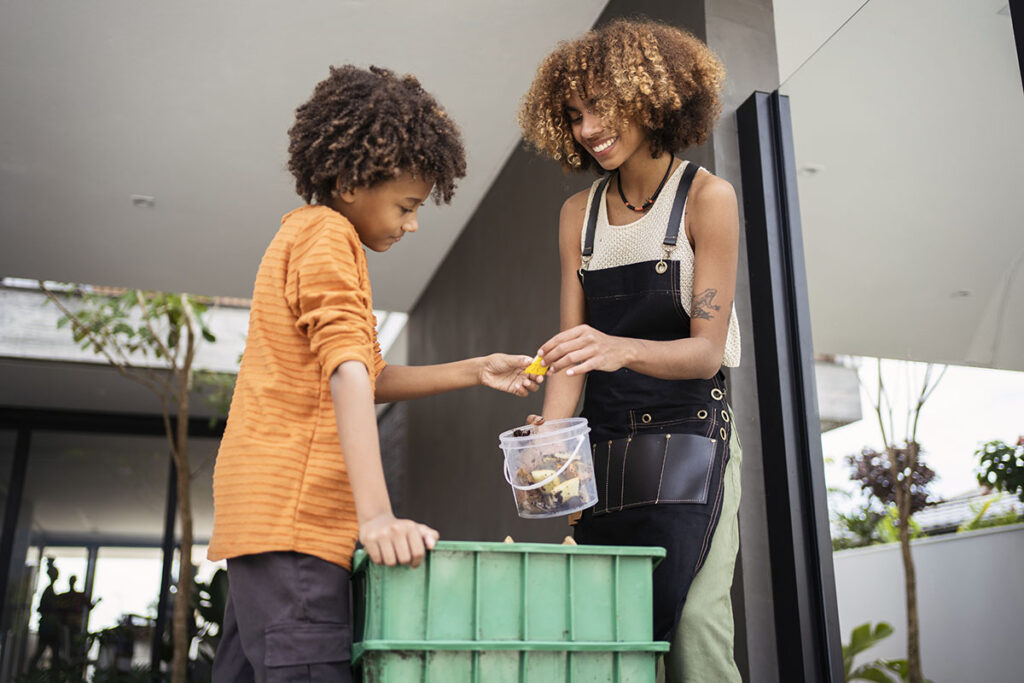Students explore the impact of food waste on our communities, focusing on how students can take action to reduce food waste. Students investigate why food is thrown away, how they can reduce the amount of food disposed of, and ensure that food waste is composted to contribute to healthy environments. Students also develop an understanding of where their food waste goes when it is thrown away instead of composted.
Students will develop an understanding of the food decomposition process, how landfilled organic waste releases greenhouse gases, and how food scraps can be used to create compost. Lessons introduce strategies that students can commit to as individuals as well as strategies that may take schoolwide effort. The unit culminates with an action plan to help students and the school community waste less food. Pairing action with learning helps students to feel empowered and hopeful.

“There is something for all different kinds of learners. We are moving spaces, drawing, talking in big and small groups, writing. Some of my kiddos who would have been disengaged quite possibly the entire time were engaged in at least two or more parts of this lesson.”
“I truly enjoyed teaching this. It has been heartwarming to see them care about other living things and the environment.”
“This did a great job of piquing students’ interest and sparking opposing points of view, which created lively discussions on the topic.”
“For my students who may not engage with abstract concepts, the real-life relevance of turning waste into soil for growing plants offers a clear, meaningful goal that they can understand and feel proud to participate in.”
“I have learned ways to improve my teaching, and I have been at this for 38 years. The students are gaining a deeper understanding of what climate change is: what causes climate change, and the impact of climate change on crop yield.”
“Students really wanted to share their food traditions and look into how climate change might affect their food traditions.”
“What I find interesting is that students are discussing the material outside of class time. I heard students discussing the ideas before class in the hallways and even during lunch periods.”
“This is engaging because it uses real data about the state students live in and shows changes within their lifetime, like the rise of warehouses and trucking during the pandemic.”
“They’ve never thought about stuff like this before, and now they’re sharing it. One girl said this was the only class that she went home and talked to her parents about.”
“The kids become more engaged because now they are actually actively doing things. They’re really having to look for themselves. It’s not given to them on a platter, but all the resources are right there.”
“Every lesson was so thoroughly designed, the case study design book was beautifully organized, and it helped to give my class a real-life understanding of how college/graduate-level academic research works. Being able to connect their research back to environmental issues they actually experience was simply icing on the cake. Well done!”
“I am so amazed and impressed by the depth of resources that you embedded in the teacher guide. This is really well put together.”

Maria Nichols, San Diego USD
Meagan Nelson-Palamara, Curriculum Developer
Angelle Lailhengue, Curriculum Developer
Emily Schell, University of San Diego
Roni Jones, Ten Strands
Stephanie Buttell-Maxin, CA Global Education Project
Chelsea Cochrane, San Diego COE
Laura Tucker, Science Educator
Sandi Yellenberg, Science Educator
Matt Ellinger, Designer
Elaine Klein, BSCS
Stacey Lane, Illustrator
Evan Schell, Evan Schell Photography
Children’s Environmental Literacy Foundation
Hannah Ammerman, Santa Rosa City Schools
Louisa Bolton-Ast, Round Valley School District
Kim Douillard, Cardiff School District
Stefanie Freele, West Side UESD
Lisa Garcia, Fremont USD
Karen Gomez, New Heights Charter School
Elena Hood, Spencer Valley ESD
Elizabeth Volmer, Jefferson ESD
Rebecca Wilcox, Los Angeles USD
You’ll get news on Seeds to Solutions and environmental literacy from Ten Strands
"*" indicates required fields
© 2025 San Mateo County Office of Education and Ten Strands | Terms of Use | Privacy Policy